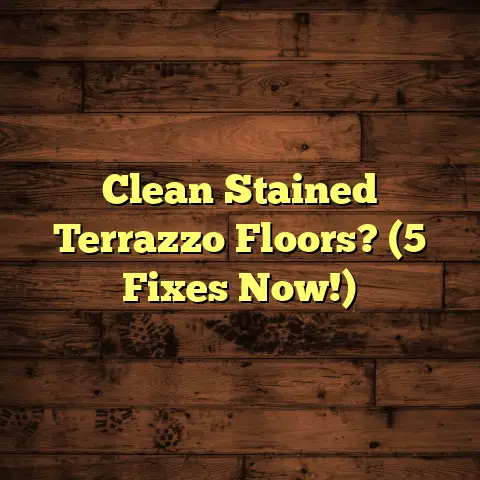How to Cover Tiles Cheaply? (9 Fast Fixes!)
Would you rather live with outdated, worn-out tile floors that make you cringe every time you see them, or find a quick and budget-friendly solution to transform them into something fresh and stylish?
I’m guessing you picked the latter!
As a flooring contractor with years of experience, I’ve seen it all – from hideous 70s linoleum to cracked and stained ceramic tiles.
And trust me, you don’t always need to rip everything out and start from scratch to achieve a stunning new look.
In this article, I’m going to share 9 fast and affordable fixes to cover those unwanted tiles and give your space a much-needed makeover.
Let’s dive in!
Section 1: Understanding the Need
for Tile Coverage
So, why would someone want to cover their tiles instead of going through the hassle (and expense!) of removing them?
There are several reasons, and I’ve heard them all from my clients over the years.
Aesthetic Updates: Maybe you just don’t like the color or style of your tiles anymore.
Tastes change, and what was trendy 20 years ago might now be an eyesore.Damage: Cracked, chipped, or stained tiles can be unsightly and even dangerous.
Covering them up is often easier and cheaper than replacing them.Style Preferences: You might be aiming for a different vibe altogether.
Perhaps you want a warmer, more inviting space and tile just isn’t cutting it.Cost-Effectiveness: Let’s be real, demolishing and replacing tile is a major project.
It involves demo, disposal, prep work, new materials, and installation.
Covering tiles is often significantly cheaper.
According to a recent survey by HomeAdvisor, the average cost to remove and replace tile flooring ranges from $5 to $20 per square foot, including labor and materials.
That can quickly add up to thousands of dollars for a large room.
Covering tiles, on the other hand, can cost as little as $1 per square foot, making it a much more budget-friendly option.
Section 2: Assessing Your Tiles
Before you jump into any of these fast fixes, it’s crucial to assess the condition of your existing tiles.
This will help you determine the best coverage method and avoid any potential problems down the road.
Here’s what I look for when I’m evaluating a client’s tiles:
Cracks: Are there any cracks in the tiles?
Small hairline cracks might not be a big deal, but larger cracks can indicate structural issues.Loose Tiles: Are any of the tiles loose or wobbly?
This can be a sign of poor adhesion, and you’ll need to address it before covering the tiles.Stains: Are there any stubborn stains that you can’t get rid of?
Some stains can bleed through certain types of coverings, so you’ll need to consider this when choosing your solution.Mismatched Colors: Are the tiles unevenly colored or faded?
This can affect the appearance of some coverings, especially those that are translucent or semi-transparent.Uneven Surface: Is the tile surface smooth and even, or are there any dips or bumps?
An uneven surface can cause problems with certain types of coverings, like peel-and-stick tiles.
If you find any significant issues, like loose tiles or major cracks, you’ll need to address them before moving forward.
You can usually repair these issues yourself with some basic tools and materials, or you can hire a professional to do it for you.
Section 3: Fast Fix #1: Peel-and-Stick
Vinyl Tiles
Peel-and-stick vinyl tiles are one of the easiest and most affordable ways to cover your existing tiles.
I’ve used them in countless projects, and my clients are always amazed at how quickly they can transform a space.
Benefits:
- Easy Installation: No special tools or
skills required.
Just peel off the backing and stick the tiles to your existing floor. - Affordable: Peel-and-stick tiles are relatively inexpensive compared to other flooring options.
- Variety of Styles: Available in a wide range of colors, patterns, and textures, including wood-look, stone-look, and geometric designs.
- Water-Resistant: Most peel-and-stick tiles are water-resistant, making them a good option for bathrooms and kitchens.
- Removable: While they’re designed to be permanent, peel-and-stick tiles can usually be removed without damaging the underlying floor.
Installation Steps:
- Clean the Existing Tiles: Thoroughly clean the existing tiles with a degreasing cleaner to remove any dirt, grease, or wax.
- Let it Dry: Ensure the floor is completely dry before you start applying the peel-and-stick tiles.
- Measure and Plan: Measure the area you
want to cover and plan the layout of the
tiles.
Start in a corner and work your way across the room. - Peel and Stick: Peel off the backing
from the first tile and carefully align
it with the edge of the wall or the
adjacent tile.
Press firmly to ensure good adhesion. - Cut to Fit: Use a utility knife to cut the tiles to fit around obstacles, like pipes or door frames.
- Repeat: Repeat steps 4 and 5 until the entire area is covered.
- Roll it: Use a floor roller to ensure the tiles are firmly adhered to the existing floor.
Necessary Tools:
- Measuring tape
- Utility knife
- Straightedge or ruler
- Degreasing cleaner
- Floor roller (optional)
Choosing the Right Style and Color:
When choosing peel-and-stick vinyl tiles, consider the overall style of your room and your personal preferences.
Do you want a modern, minimalist look, or something more traditional and rustic?
Also, think about the color scheme of your room and choose tiles that complement your existing decor.
Pro Tip: Order a few extra tiles to
account for mistakes or future repairs.
It’s always better to have too much than
not enough!
Section 4: Fast Fix #2: Area Rugs and Mats
Area rugs and mats are a classic and versatile way to cover up unwanted tiles.
They’re also one of the easiest and most affordable options, and they can instantly transform the look and feel of a room.
Benefits:
- Easy to Install: Just unroll and place the rug or mat on top of the existing tiles.
- Affordable: Area rugs and mats come in a wide range of prices, so you can find something that fits your budget.
- Variety of Styles: Available in countless colors, patterns, sizes, and materials.
- Comfortable: Adds warmth and softness to hard tile floors.
- Temporary: Easy to move or remove whenever you want.
Tips for Selecting the Right Size, Style, and Material:
Size: Choose a rug or mat that’s appropriate for the size of your room.
A rug that’s too small will look out of place, while a rug that’s too large can overwhelm the space.As a general rule, leave about 12-18 inches of bare floor around the perimeter of the room.
-
Style: Consider the overall style of your room and choose a rug or mat that complements your existing decor.
If you have a modern, minimalist room, look for a rug with a simple geometric pattern or a solid color.
If you have a more traditional room, consider a rug with an ornate floral pattern or a rich, saturated color.
-
Material: The material of your rug or mat will affect its durability, comfort, and maintenance.
Wool rugs are soft, durable, and stain-resistant, but they can be expensive.
Synthetic rugs (like nylon or polyester) are more affordable and easier to clean, but they’re not as durable as wool.
Cotton rugs are soft and comfortable, but they’re not as durable or stain-resistant as wool or synthetic rugs.
-
Consider the Function of the Room: Think about how the room is used and choose a rug or mat that’s appropriate for the level of traffic and activity.
For high-traffic areas, like hallways and entryways, choose a durable rug with a low pile.
For bedrooms and living rooms, you can opt for a softer, more luxurious rug with a higher pile.
Pro Tip: Use a rug pad underneath your area rug to prevent it from slipping and sliding, and to protect your existing tiles from scratches.
Section 5: Fast Fix #3: Paint the Tiles
Painting your tiles is a surprisingly effective way to cover them up and give them a fresh new look.
I know what you’re thinking: “Paint on tile? Will that even work?”
Trust me, it does!
With the right preparation and the right type of paint, you can achieve a durable and long-lasting finish.
Benefits:
- Affordable: Paint is relatively inexpensive compared to other flooring options.
- Customizable: You can choose any color you want to match your existing decor.
- Easy to Apply: With some basic tools and skills, you can paint your tiles yourself.
- Durable: With proper preparation and the right type of paint, you can achieve a durable and long-lasting finish.
Process of Painting Over Tiles:
- Clean the Tiles: Thoroughly clean the tiles with a degreasing cleaner to remove any dirt, grease, or wax.
- Sand the Tiles: Lightly sand the tiles with fine-grit sandpaper to create a slightly rough surface for the paint to adhere to.
- Prime the Tiles: Apply a coat of tile-specific primer to help the paint bond to the tiles.
- Paint the Tiles: Apply two coats of high-quality epoxy paint, allowing each coat to dry completely before applying the next.
- Seal the Tiles: Apply a coat of clear polyurethane sealant to protect the paint and make it more durable.
Choosing the Right Paint:
When painting tiles, it’s crucial to use the right type of paint.
Regular latex paint won’t adhere well to tile and will quickly chip and peel.
Instead, you’ll want to use a high-quality epoxy paint that’s specifically designed for tile surfaces.
Epoxy paint is durable, water-resistant, and provides a hard, glossy finish.
Achieving a Lasting Finish:
To ensure a lasting finish, it’s important to properly prepare the tiles and apply the paint correctly.
Make sure to thoroughly clean and sand the tiles before priming, and apply thin, even coats of paint.
Allow each coat of paint to dry completely before applying the next, and don’t skip the sealant!
Pro Tip: Practice painting on a spare
tile or in an inconspicuous area before
painting the entire floor.
This will give
you a chance to get a feel for the paint
and make sure you’re happy with the color
and finish.
Section 6: Fast Fix #4: Laminate Flooring
Laminate flooring is a popular and budget-friendly alternative to tile.
It’s made of a composite material that’s designed to mimic the look of wood, stone, or tile, and it’s available in a wide range of colors and styles.
Benefits:
- Affordable: Laminate flooring is generally less expensive than tile.
- Easy to Install: Most laminate flooring is designed to be installed as a floating floor, which means it doesn’t need to be glued or nailed down.
- Durable: Laminate flooring is scratch-resistant, stain-resistant, and water-resistant, making it a good option for high-traffic areas.
- Easy to Clean: Laminate flooring is easy to clean with a damp mop or cloth.
Installation Process:
- Prepare the Existing Tiles: Clean the existing tiles and make sure they’re level.
- Install Underlayment: Install a layer of underlayment over the tiles to provide a smooth, even surface for the laminate flooring.
- Install the Laminate Flooring: Start in a corner and work your way across the room, interlocking the laminate planks or tiles as you go.
- Cut to Fit: Use a saw to cut the laminate planks or tiles to fit around obstacles, like pipes or door frames.
- Install Baseboards: Install baseboards around the perimeter of the room to cover the edges of the laminate flooring.
Benefits of Floating Floors:
Floating floors are a type of flooring that’s not attached to the subfloor.
Instead, the planks or tiles are interlocked together and “float” on top of the subfloor.
This type of installation is quick, easy, and doesn’t require any special tools or skills.
Laying Laminate Over Existing Tiles:
Laying laminate flooring over existing tiles is a great way to save time and money.
As long as the tiles are level and in good condition, you can simply install the underlayment and laminate flooring directly on top of them.
Pro Tip: Before installing laminate
flooring, let it acclimate to the room for
at least 48 hours.
This will allow the
laminate to expand or contract to the room’s
temperature and humidity, which will help
prevent warping or buckling.
Section 7: Fast Fix #5: Tile Decals and
Stickers
Tile decals and stickers are a fun and creative way to refresh the look of your existing tiles without making any permanent changes.
They’re available in a wide range of designs, from simple geometric patterns to intricate floral motifs, and they can be easily applied and removed.
Benefits:
- Easy to Install: Just peel and stick the decals or stickers to your existing tiles.
- Affordable: Tile decals and stickers are relatively inexpensive.
- Variety of Designs: Available in a wide range of colors, patterns, and styles.
- Removable: Easy to remove without damaging the underlying tiles.
- Customizable: You can mix and match different designs to create a unique look.
Examples of Available Designs:
- Geometric patterns
- Floral motifs
- Moroccan-inspired designs
- Abstract art
- Solid colors
How to Apply Tile Decals Effectively:
- Clean the Tiles: Thoroughly clean the tiles with a degreasing cleaner to remove any dirt, grease, or wax.
- Dry the Tiles: Ensure the tiles are completely dry before applying the decals or stickers.
- Position the Decal: Carefully position the decal or sticker on the tile, making sure it’s aligned properly.
- Smooth the Decal: Use a squeegee or credit card to smooth the decal or sticker onto the tile, working from the center outwards to remove any air bubbles.
- Repeat: Repeat steps 3 and 4 until all the tiles are covered.
Pro Tip: For best results, choose tile
decals or stickers that are specifically
designed for use on tile surfaces.
These
decals are typically made of a durable,
water-resistant material that will withstand
the rigors of daily use.
Section 8: Fast Fix #6: Carpet Tiles
Carpet tiles are a versatile and comfortable way to cover your existing tiles while adding warmth and softness to your space.
They’re available in a wide range of colors, patterns, and textures, and they can be easily installed and removed.
Benefits:
- Easy to Install: Most carpet tiles are designed to be installed as a floating floor, which means they don’t need to be glued or nailed down.
- Comfortable: Adds warmth and softness to hard tile floors.
- Variety of Styles: Available in a wide range of colors, patterns, and textures.
- Easy to Clean: Carpet tiles are easy to clean with a vacuum cleaner or spot cleaner.
- Replaceable: If one tile gets damaged, you can easily replace it without having to replace the entire floor.
Installation Process:
- Prepare the Existing Tiles: Clean the existing tiles and make sure they’re level.
- Install Underlayment: Install a layer of underlayment over the tiles to provide a smooth, even surface for the carpet tiles.
- Install the Carpet Tiles: Start in a corner and work your way across the room, interlocking the carpet tiles as you go.
- Cut to Fit: Use a utility knife to cut the carpet tiles to fit around obstacles, like pipes or door frames.
Maintenance Tips:
- Vacuum regularly to remove dirt and debris.
- Spot clean spills immediately to prevent staining.
- Use a carpet cleaner to deep clean the tiles periodically.
Mixing and Matching Colors:
One of the great things about carpet tiles is that you can mix and match different colors and patterns to create a unique and personalized look.
Try creating a checkerboard pattern, a striped pattern, or a random mix of colors to add some visual interest to your floor.
Pro Tip: When installing carpet tiles,
make sure to rotate them 90 degrees to
create a more uniform look.
This will help
to hide any slight variations in color or
texture between the tiles.
Section 9: Fast Fix #7: Floor Cloths or Mats
Floor cloths or mats are a stylish and practical way to cover your existing tiles while adding a touch of personality to your space.
They’re typically made of durable fabric, like canvas or vinyl, and they’re available in a wide range of colors, patterns, and sizes.
Benefits:
- Easy to Install: Just unroll and place the floor cloth or mat on top of the existing tiles.
- Affordable: Floor cloths and mats come in a wide range of prices, so you can find something that fits your budget.
- Variety of Styles: Available in countless colors, patterns, sizes, and materials.
- Comfortable: Adds a soft and stylish surface to hard tile floors.
- Easy to Clean: Floor cloths and mats are easy to clean with a damp mop or cloth.
Tips for Choosing the Right Fabric and Size:
-
Fabric: Choose a fabric that’s durable, water-resistant, and easy to clean.
Canvas is a good option for high-traffic areas, as it’s tough and long-lasting.
Vinyl is a good option for bathrooms and kitchens, as it’s water-resistant and easy to wipe clean.
-
Size: Choose a floor cloth or mat that’s appropriate for the size of your room.
A floor cloth or mat that’s too small will look out of place, while a floor cloth or mat that’s too large can overwhelm the space.
As a general rule, leave about 6-12 inches of bare floor around the perimeter of the floor cloth or mat.
Pro Tip: To prevent your floor cloth or
mat from slipping and sliding, use a rug
pad underneath it.
This will also help to
protect your existing tiles from scratches.
Section 10: Fast Fix #8: Overlays and
Resurfacing
Overlays and resurfacing are a more advanced way to cover your existing tiles and create a modern, seamless look.
They involve applying a thin layer of material, like concrete or epoxy, over the existing tiles to create a new, smooth surface.
Benefits:
- Seamless Look: Creates a smooth, seamless surface that hides the existing tiles.
- Modern Aesthetic: Provides a modern, industrial look that’s popular in contemporary homes.
- Durable: Overlays and resurfacing materials are typically very durable and long-lasting.
- Customizable: You can choose from a wide range of colors, textures, and finishes to create a unique look.
Steps Involved in the Application Process:
- Prepare the Existing Tiles: Clean the existing tiles and make sure they’re level.
- Apply a Bonding Agent: Apply a bonding agent to the tiles to help the overlay material adhere properly.
- Mix the Overlay Material: Mix the overlay material according to the manufacturer’s instructions.
- Apply the Overlay Material: Apply the overlay material to the tiles, spreading it evenly with a trowel or squeegee.
- Allow to Dry: Allow the overlay material to dry completely.
- Sand the Surface: Sand the surface to create a smooth, even finish.
- Seal the Surface: Seal the surface to protect it from stains and moisture.
Potential Costs:
Overlays and resurfacing can be more expensive than other tile-covering options, as they typically require professional installation.
The cost will vary depending on the type of material you choose, the size of the area you’re covering, and the labor rates in your area.
However, if you’re looking for a durable, long-lasting solution that will completely transform the look of your floor, overlays and resurfacing may be worth the investment.
Pro Tip: When choosing an overlay
material, consider the level of traffic in
the area you’re covering.
For high-traffic
areas, choose a material that’s highly
durable and scratch-resistant.
Section 11: Fast Fix #9: Temporary
Flooring Solutions for Renters
If you’re a renter, you may not be able to make permanent changes to your flooring.
But that doesn’t mean you have to live with ugly tiles!
There are several temporary flooring solutions that you can use to cover your tiles without damaging them or violating your lease agreement.
Removable Floor Coverings:
Removable floor coverings are designed to be easily installed and removed without leaving any residue or damage.
They’re available in a variety of styles, including peel-and-stick tiles, interlocking mats, and roll-out vinyl flooring.
Temporary Wallpaper for Tiles:
Temporary wallpaper for tiles is a great way to add some color and pattern to your bathroom or kitchen without making any permanent changes.
It’s available in a wide range of designs, and it can be easily applied and removed with just a few simple tools.
Advantages of These Methods in Rental Properties:
- Non-Permanent: These methods don’t require any permanent changes to the property, so you won’t have to worry about violating your lease agreement.
- Affordable: Temporary flooring solutions are typically very affordable, making them a great option for renters on a budget.
- Easy to Install: These methods are easy to install and remove, so you can quickly transform your space without any hassle.
- Customizable: You can choose from a wide range of colors, patterns, and styles to create a look that’s uniquely your own.
Pro Tip: Before installing any temporary flooring solution, check with your landlord to make sure it’s allowed under your lease agreement.
Conclusion:
So, there you have it – 9 fast and affordable fixes to cover those unwanted tiles and transform your space without breaking the bank!
From peel-and-stick vinyl tiles to area rugs and mats, there’s a solution for every style and budget.
Remember, the key is to get creative and resourceful.
Don’t be afraid to mix and match different solutions to create a look that’s uniquely your own.
And most importantly, have fun with it!
Transforming your space should be an enjoyable experience, so don’t stress too much about getting everything perfect.
Just explore your options, find a solution that fits your style and budget, and get ready to enjoy your newly transformed space!





